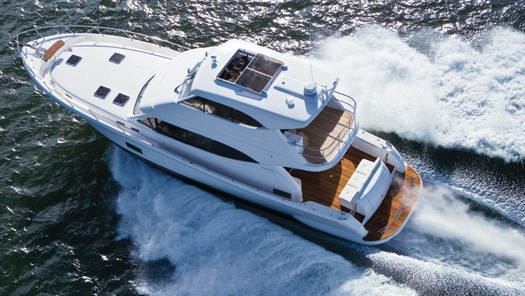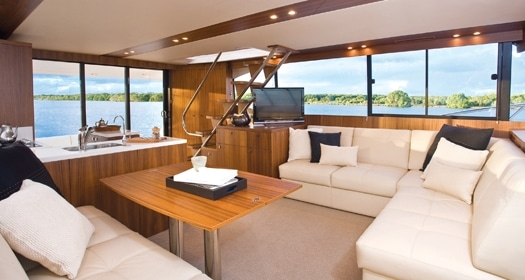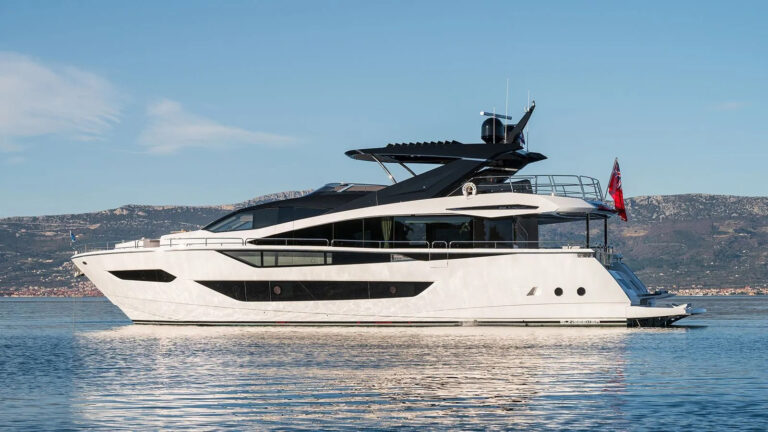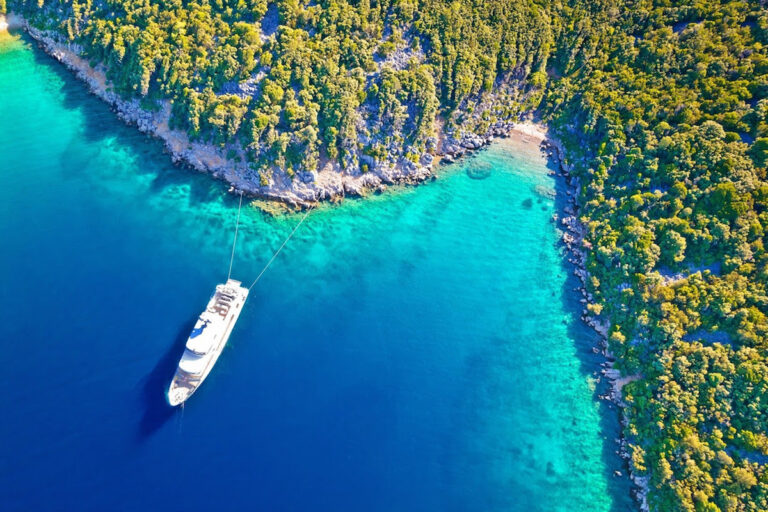
ytgaug09marit525.jpg
A few decades ago, it seemed that the conventional wisdom along the waterfront was that for a yacht to be a capable cruiser, it had to be primitive and bulky, with maybe a few streaks of rust running down the hull for good measure. In other words, it had to be hard on the eyes. To complement the exterior presentation, the interior should have spartan accommodations. Items such as settees needed to offer the same comfort level as a church pew. The only hint of civility was a few cedar chips glued to the back of a hanging locker to give your wool sweater the scent of a hamster cage.
And what about speed? Ah, well, the slower the better-anything forward of reverse would suffice. If a cruising sailboat or a rowing shell couldn’t pass you, then the design must be a winner. Don’t get me wrong. I’m all about slowing down and enjoying the journey, having made multiple ocean passages on just this type of craft. In fact, I’ve thought that my next boat may be a salty, commercial-style trawler that will allow me to say goodbye to the world for a while as I roam to distant ports.
However, I’m now anticipating a prickly issue when I start the search process. You see, after spending five days in Australia running and dissecting several Maritimo models, including the new 56, I realize that a good cruising boat with a seakindly hull, lots of comfort, a pleasing profile, and yes, a good turn of speed, is in fact a reality. The 56 is perfectly suited for coastal cruising, long stretches down to the Caribbean, or exploring Alaska’s inside passage.
Leave it to a scrappy Australian boatbuilder to turn things upside down and force the evolution of the cruising boat. Maritimo is the creation of Bill Barry-Cotter, who also founded Riviera Yachts. Barry-Cotter, in my opinion, could be a model for the ideal boatbuilder-the very gentleman you want to build your boat. He’s obsessed with making a better product and his eyes begin to twinkle when he discusses his latest creation. His actions are not guided by pure whimsy; in fact, he possesses a wealth of knowledge cultivated from 40 years of boatbuilding. When he’s not poring over minor details well after the shop closes, he’s cruising his Maritimo 60 Sports Cabriolet or racing with the Maritimo Offshore Race Team. Indeed, he’s one of the most authentic boatbuilders I’ve met in years, and you’d better believe that his boats reflect his passion and his skill set.

| | |
“Here, let me show you this,” he said pointing to the shallow, ninedegree shaft angle on the 56. “No need for tunnels. Tunnels funnel fuel.” This is a principle carried through on all the Maritimos. The 56 pops out of the hole, and without touching trim tabs, we reach a cruising speed of 28 knots in less than 15 seconds. With a pair of 775-horsepower Volvo D12 diesels, expect a top speed of 33 knots. The shaft angle also allows for smaller (read more efficient) horsepower packages. “We can put in the 1,000-horsepower Cats-some in the American market demand it-but the boat is designed to run efficiently with smaller engines.” His words played in my head over and over as I put the stout cruiser through her paces. The easy motion in a seaway accentuated the level ride. The great ride isn’t surprising but certainly is welcome, considering the fact that not far from Maritimo’s factory is some of most unforgiving coastline in the world.
To further ensure performance and efficiency, the company manufactures its own propellers. I’ve been around the world testing boats and touring factories, and my trip to Maritimo was the first time I was in a builder’s foundry. “It gives us more control,” Barry-Cotter said. Along with props, the builder manufactures its own shafts, rudders, skegs, and through-hull fittings. Not only does this allow the Maritimo team to monitor quality, but it also builds in flexibility. Pairing props to an engine package often requires some tweaking, especially on new builds. For Maritimo, the process no longer involves a middleman and possibly weeks of delays. Ultimately, this means that when a Maritimo arrives at the dealer, it is completely dialed in and ready to perform.
During our sea trials, I grew fond of the 56’s enclosed bridge-a feature shared with most of her siblings in the 13-model lineup. The 56 does, however, sport new design cues such as additional rake to the forward slope of the cabin house, and the elimination of the flying bridge side overhangs. While at the helm, I imagined that I was delivering the 56 to the Virgin Islands. I pictured the environment during the day with the overhead sunroof calling out for the sun and fresh breezes to come on in, while my crew spread out comfortably on the L-shaped or straight settees. After a day of running, I wouldn’t be coated in salt and sporting a hairdo that resembled Medusa’s. Indeed, on the 56, I would be wrapped in security and comfort.

| | |
Snapping out of my daze, I noticed the helm’s practical features. The engine gauges were placed perfectly in the line of sight. To the left of the helm, two Simrad displays were housed in the molded console, just forward of the companion helm seat. I like this treatment. It allows the mate and helmsman to work together to pilot in tight situations, such as heavy fog, or when running a tough inlet at night, because- remember!-the 56 is designed to leave the dock and cruise. If this was my boat, I would ask that the thruster controls be moved to the left of the wheel, versus being placed directly above the gear and throttles. In my opinion, it would allow for a more natural body orientation during tight docking situations. A three-panel sliding door across the after bulkhead allows for a flawless line of sight aft, and, combined with the sunroof, provides the airiness of an open bridge that some buyers hesitate to give up.
Another plus of the design was the easy access from the bridge to the lower deck. The staircase was built with a gradual angle, allowing crew to carry lunch up to a hungry captain with ease. The salon and galley layout are practical, albeit not conventional-a trait I came to expect from a boat with Barry-Cotter’s stamp. The layout places the galley abaft the settees, right inside the entrance to the afterdeck. This addresses a few issues. First, the galley is close to the bridge stairs for easy access. Secondly, when you move the activity to the afterdeck, the door can be opened to provide a seamless entertainment space.
The 56’s galley features an island with cabinets underneath. During our cruise, this island threw out a gravitational pull for everyone to hang out and gather over a few appetizers. I had a similar reaction of “Hmm, that really makes sense” to the way the rest of the space was arranged. Forward of the galley, there is a straight dinette that makes plating and serving easy. Opposite the dinette is a plush L-shaped settee. And 360 degrees of windows give you great views. In essence, the 56 has its own great room, with cooking, dining, and lounging all in one large area. Plus, the enclosed bridge offers a second salon area for cozier moods.

| | |
Forward, there is a three-stateroom, two-head layout. The master is to port and has an island berth and en suite head. The large hull port provides a great view to watch the awakening of a morning anchorage while enjoying a cup of coffee. The forward cabin also features an island double and plenty of ventilation. A single stateroom is to starboard. Maritimo finished the entire interior in satin teak that was flawlessly executed.
The same level of finish was evident in the engineroom. Routine, and even major, service will be easily accomplished. Fuel filters are placed perfectly, and outboard access is more than adequate. Wiring and plumbing runs were neat and tidy, giving the air of a boat that was totally shipshape.
The Maritimo 56 is scheduled to make its U.S. debut this fall. My guess is that Bill Barry-Cotter will probably have tweaked and polished this peppy cruising boat that’s built to take a beating even more since the first hull we tested. Luckily for us, he just can’t help himself.
For a full listing of dealers, log onto **www.maritimo.com.au**









